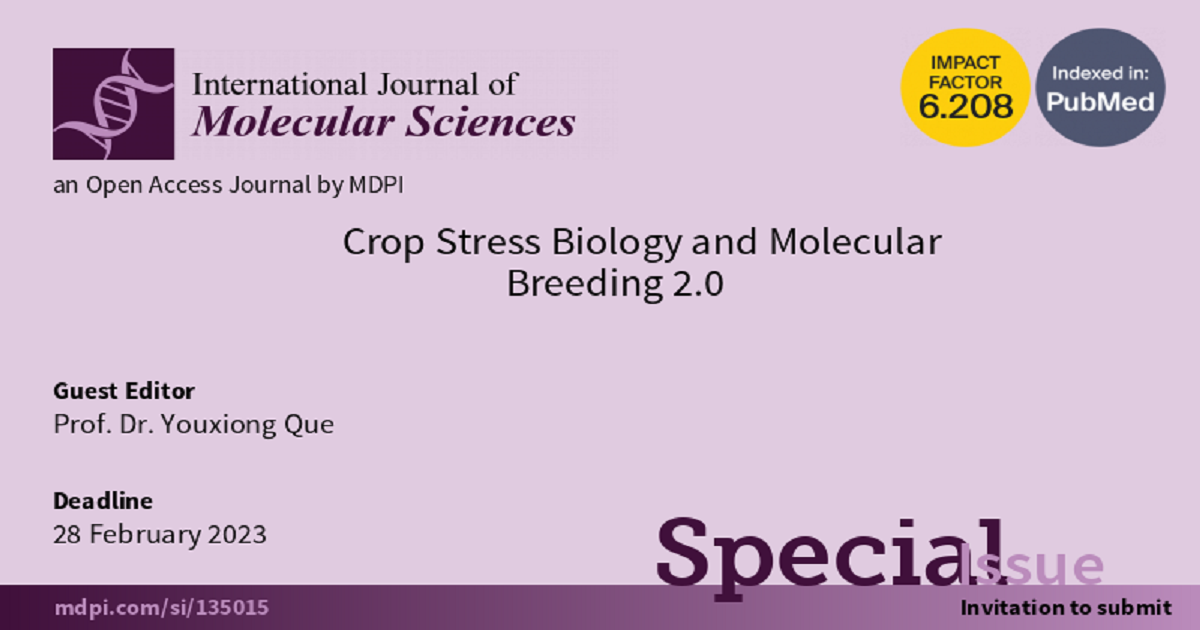Crop Stress Biology and Molecular Breeding 2.0
A special issue of International Journal of Molecular Sciences (ISSN 1422-0067). This special issue belongs to the section "Molecular Plant Sciences".
Deadline for manuscript submissions: closed (28 February 2023) | Viewed by 78319

Special Issue Editor
2. National Engineering Research Center for Sugarcane, Ministry of Science &Technology, Fujian Agriculture and Forestry University, Fuzhou 350002, China
Interests: crop genetics and biotechnology; molecular interaction between crop and pathogen; gene mining and function identification; molecular breeding
Special Issues, Collections and Topics in MDPI journals
Special Issue Information
Dear Colleagues,
Biotic and abiotic stresses limit variety improvement and cultivation regulation of crops, including but not limited to rice, corn, sorghum, wheat, cotton, rape, peanut, soybean, sugarcane and beet, and thus seriously restrict the corresponding industrial developments. The response and adaptation mechanisms of crops to these stresses have remained unclear. Focusing our research efforts on crop stress biology and molecular breeding through genetic, genomics, molecular biology and other approaches is therefore vitally important. Current studies in this field seek to reveal the biological basis and processes of important crop traits, including genomics, genes and gene networks; to elucidate the signal transduction pathway of crop stress responses and its interaction mechanism with corresponding stress factors; to elaborate upon the adaptation mechanisms of crops in response to their environment (stress); and to discover and identify key genes and interacting proteins that regulate the formation of traits or adapt to the environment. The exploration of these areas will no doubt reveal gene elements or targets that can be utilized for genetic improvement of important agronomic traits and assist in enhancing crop characteristics or even creating novel germplasms.
This Special Issue, “Crop Stress Biology and Molecular Breeding 2.0”, welcomes original research and review papers considering biological process analysis of important crop traits, crop gene cloning and functional identification, the screening of linkage markers for crop target traits and all other related processes. Papers detailing bioinformatics tools and databases used for crop stress biology and molecular breeding research are also welcomed.
Prof. Dr. Youxiong Que
Guest Editor
Manuscript Submission Information
Manuscripts should be submitted online at www.mdpi.com by registering and logging in to this website. Once you are registered, click here to go to the submission form. Manuscripts can be submitted until the deadline. All submissions that pass pre-check are peer-reviewed. Accepted papers will be published continuously in the journal (as soon as accepted) and will be listed together on the special issue website. Research articles, review articles as well as short communications are invited. For planned papers, a title and short abstract (about 100 words) can be sent to the Editorial Office for announcement on this website.
Submitted manuscripts should not have been published previously, nor be under consideration for publication elsewhere (except conference proceedings papers). All manuscripts are thoroughly refereed through a single-blind peer-review process. A guide for authors and other relevant information for submission of manuscripts is available on the Instructions for Authors page. International Journal of Molecular Sciences is an international peer-reviewed open access semimonthly journal published by MDPI.
Please visit the Instructions for Authors page before submitting a manuscript. There is an Article Processing Charge (APC) for publication in this open access journal. For details about the APC please see here. Submitted papers should be well formatted and use good English. Authors may use MDPI's English editing service prior to publication or during author revisions.
Keywords
- biotic and abiotic stress
- variety improvement
- crop stress biology
- molecular breeding
- biological basis
- signal transduction pathway
- agronomic traits
- excellent germplasm
Benefits of Publishing in a Special Issue
- Ease of navigation: Grouping papers by topic helps scholars navigate broad scope journals more efficiently.
- Greater discoverability: Special Issues support the reach and impact of scientific research. Articles in Special Issues are more discoverable and cited more frequently.
- Expansion of research network: Special Issues facilitate connections among authors, fostering scientific collaborations.
- External promotion: Articles in Special Issues are often promoted through the journal's social media, increasing their visibility.
- e-Book format: Special Issues with more than 10 articles can be published as dedicated e-books, ensuring wide and rapid dissemination.
Further information on MDPI's Special Issue policies can be found here.






